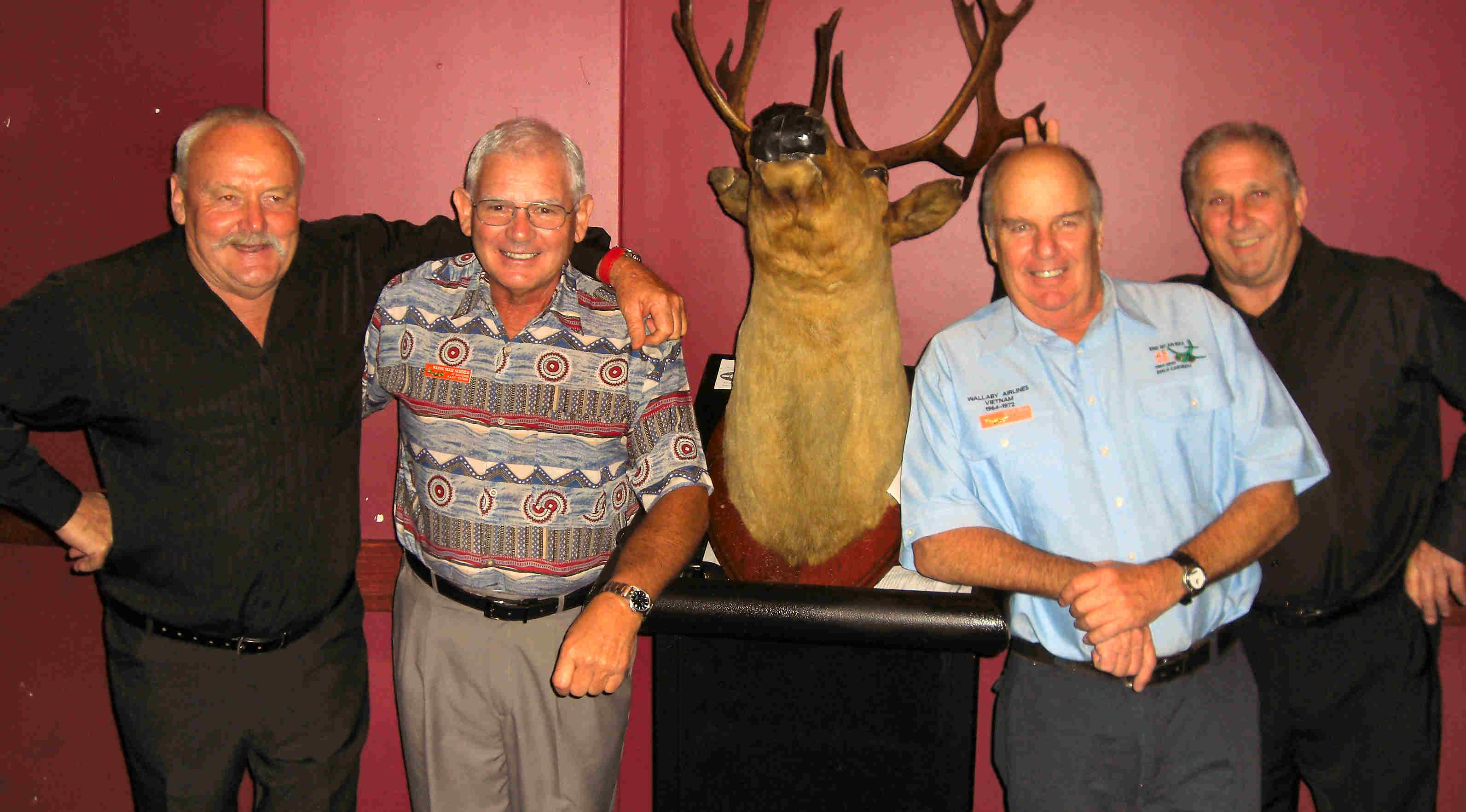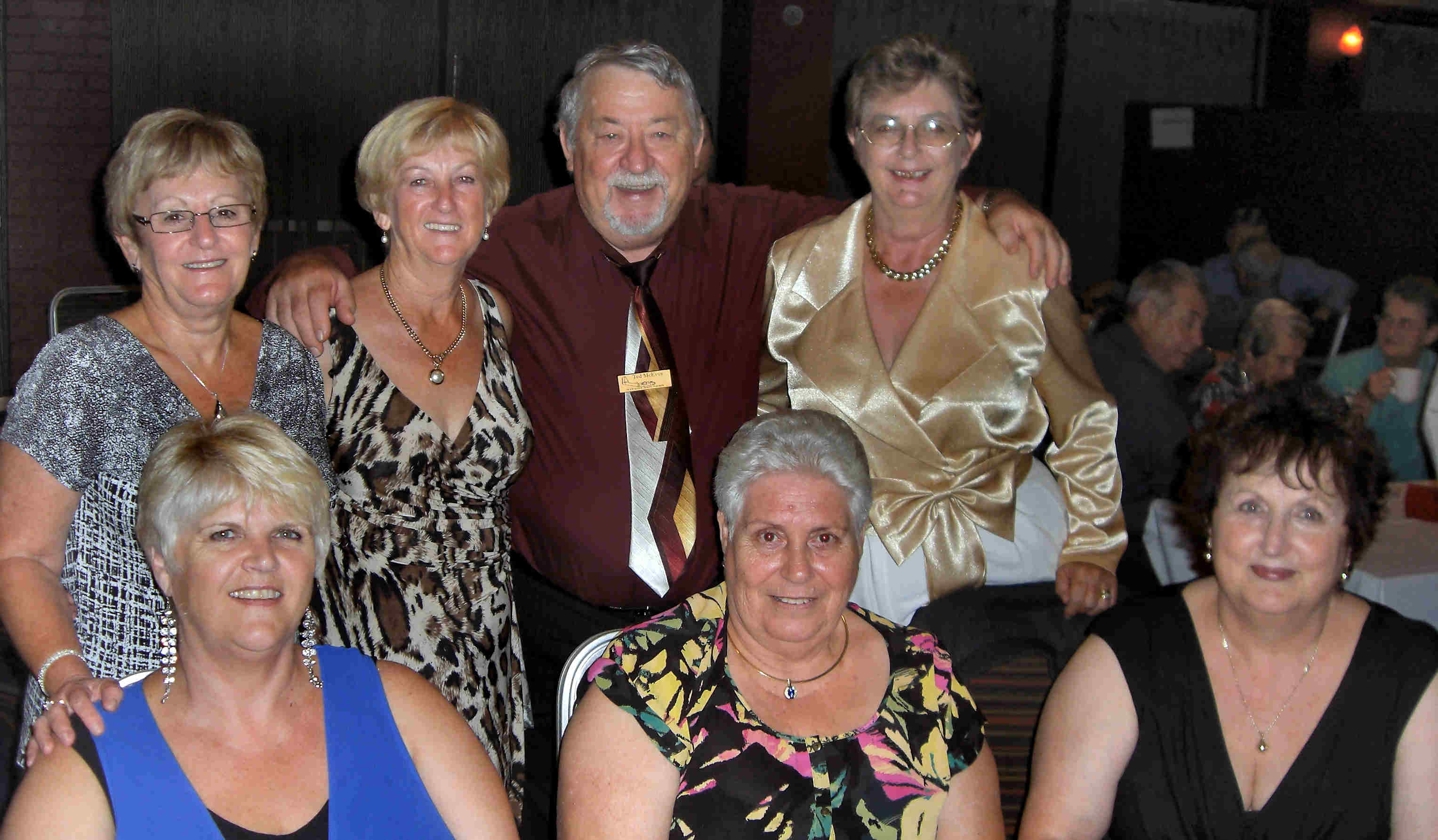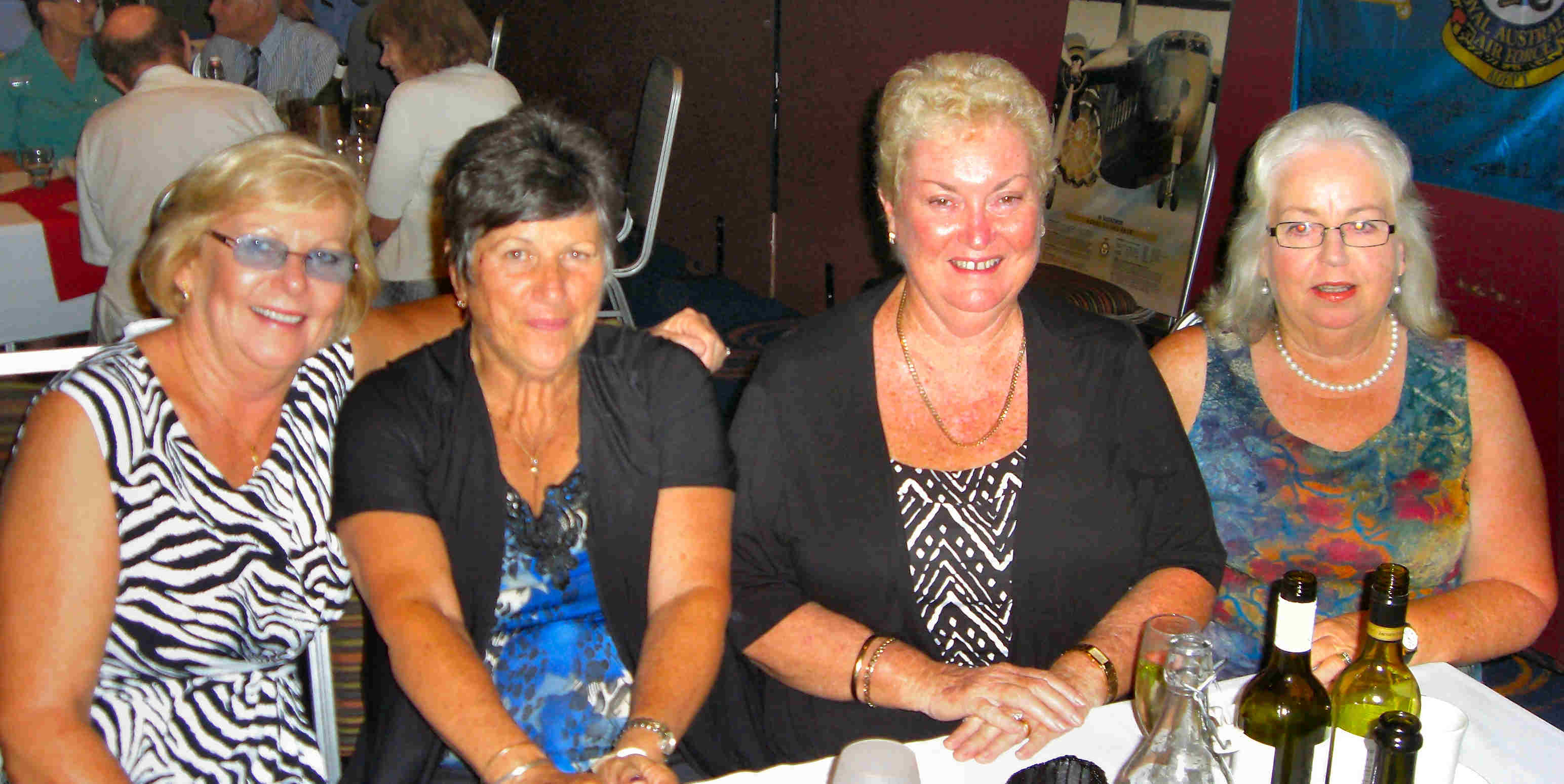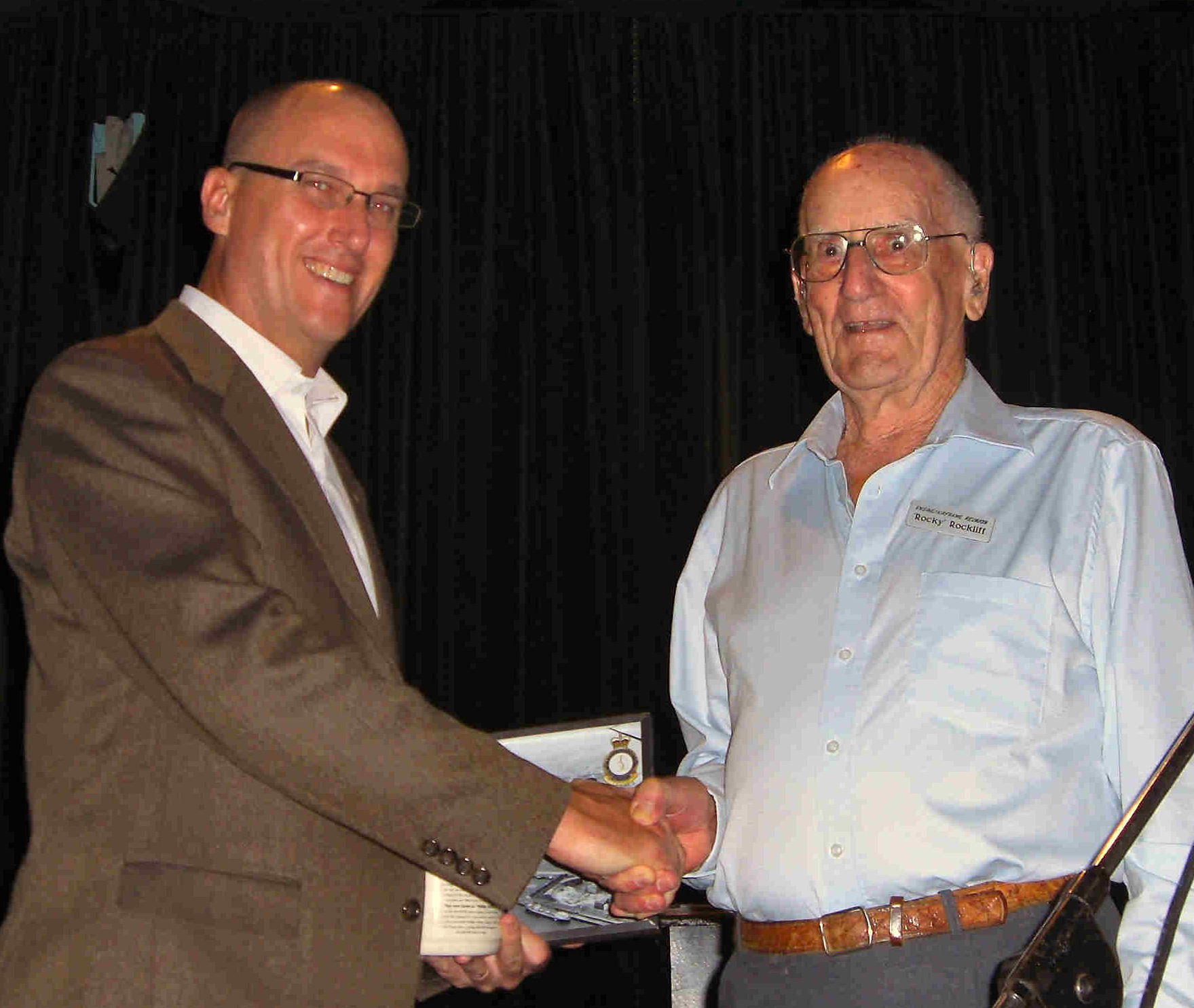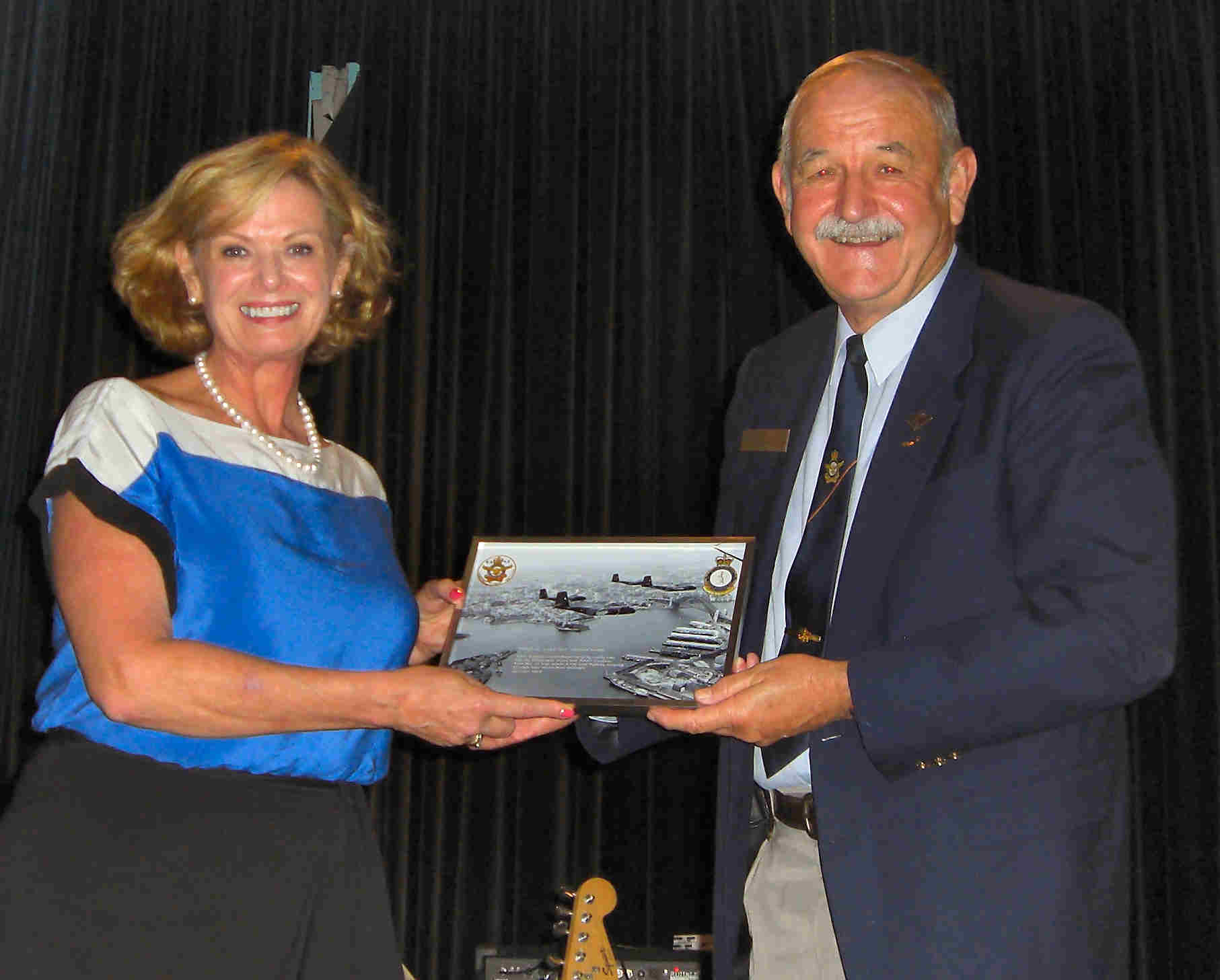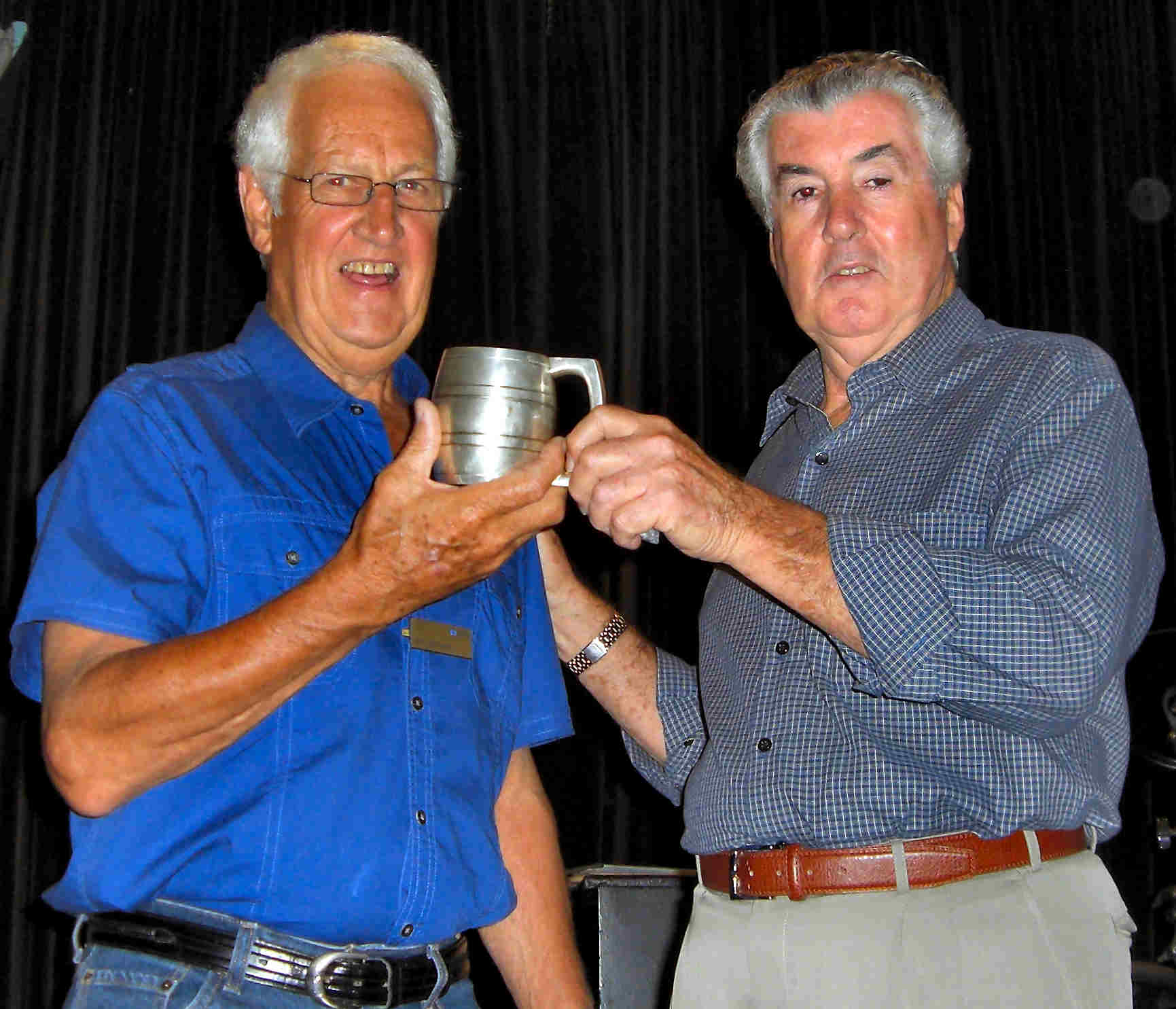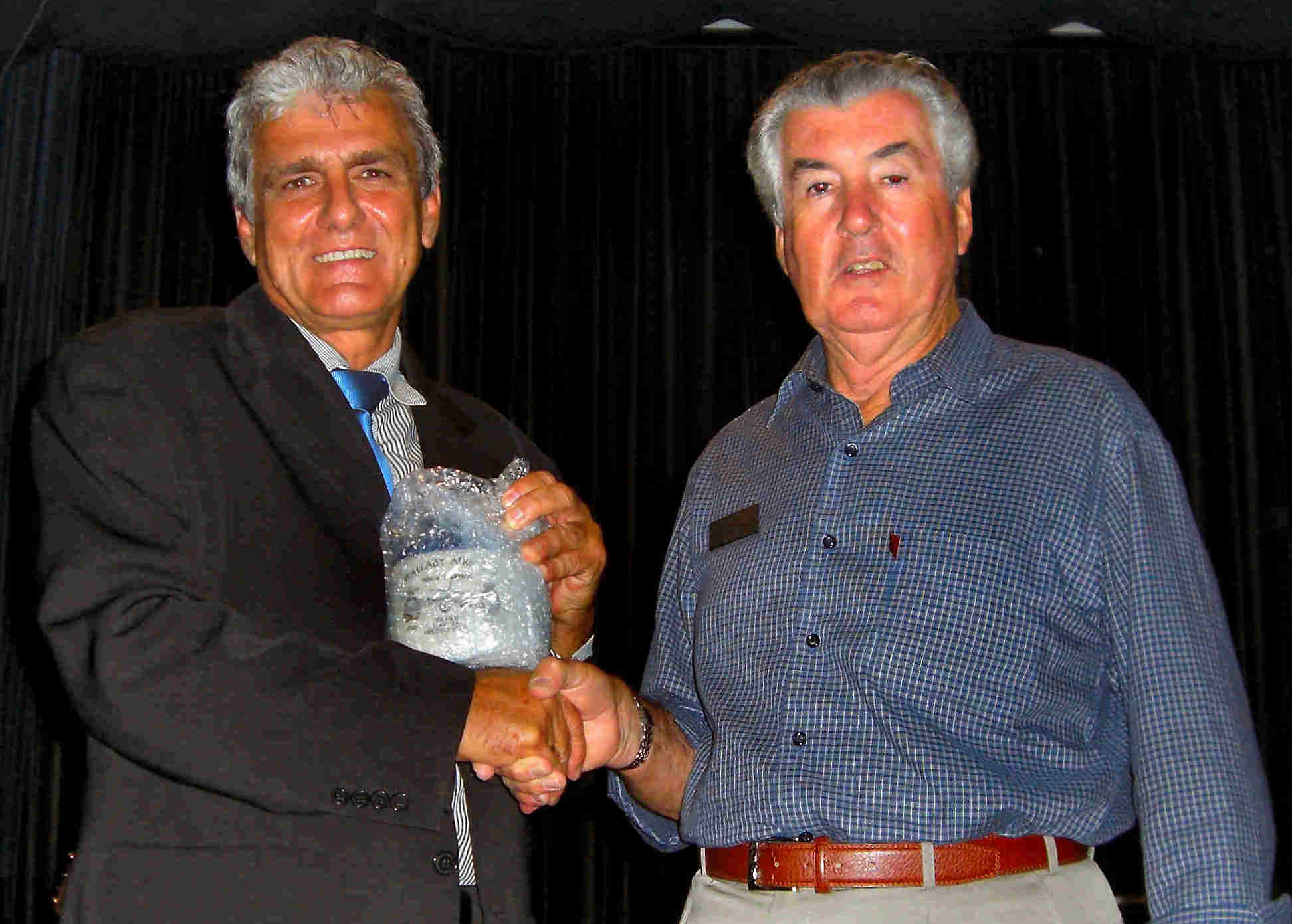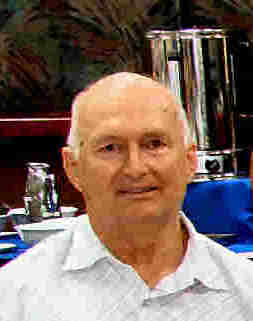|
|
|||||||
|
Radschool Association Magazine - Vol 39 Page 15 |
|||||||
|
Privacy Policy | Editorial Policy | Profit Policy | Join the Association | List of Members | Contact us | Index | Links |
|||||||
|
Back Go to page: 1 2 3 4 5 6 7 8 9 10 11 12 13 14 15 16 17 18 19 20 Forward |
|||||||
|
RTFV-35 Sqn Reunion.
On the Monday morning, everyone boarded the buses from outside the Oaks Apartments in Charlotte St and set off on the 80 minute trip to the Caloundra Airport for a conducted tour of the Queensland Air Museum (QAM)
The QAM had its beginnings in 1973 when a group of aviation enthusiasts who comprised the Queensland Branch of the Aviation Historical Society of Australia decided to "put their money where their mouths were" and do something about preserving Australia's aviation heritage by purchasing a Canberra bomber. The fact that the fledgling museum had no suitable site to display such an aircraft was not allowed to stand in the way of their enthusiasm!
As a result of the considerable media publicity which followed, the Canberra was moved to the new "Pioneer Valley Park" horse-drawn vehicle museum at Kuraby on the 2nd June 1974 thus inaugurating the Queensland Air Museum.
Almost exactly one year later, the collection doubled in size with the arrival of Meteor WD647. The Museum's second aircraft acquisition was in complete contrast to the first in that it was an outright gift from the British Government, whereas the Canberra had to be purchased from the Australian Government. The Meteor was destined never to join the Canberra at Kuraby, for sadly "Pioneer Valley Park" closed, and QAM found itself thrust into a nomadic existence which was to last for another 10 years! It is a lasting tribute to the members involved that the Museum survived the tribulations that followed.
In May 1977, the Canberra was moved to a leased site at Lower Nudgee where it was later joined by the Meteor, Sea Venoms WZ910 and WZ898 and Vampire A79-828. With the development of the new Brisbane Airport floodway, QAM had to go, and after much anguish and lobbying, the aircraft were moved to a "temporary holding area" on Brisbane Airport in April 1980. During QAM's occupancy of this site, the Canberra featured in a much-publicised extortion attempt against Trans-Australia Airlines. Although local Department of Aviation officials were sympathetic towards QAM, the Minister of the day had an apparent personal vendetta against the Museum and exorbitant rental demands effectively led to QAM's eviction from Brisbane Airport.
The resultant publicity came to the attention of Landsborough Shire Councillor, John Harrison, who persuaded the Council to facilitate QAM's relocation to Caloundra. The offer of a modern hangar type building on Caloundra Aerodrome was too good to refuse, and the Canberra, Meteor and two Sea Venoms were transported to Caloundra on 14 June 1986. By this time, only the Meteor was ready for display, so a band of local volunteer members set about preparing the collection for an opening ceremony on 4 April 1987. The fact that a respectable display was ready on schedule is a tribute to the members involved. The official opening of the Museum was performed by Mrs. Ly Bennett, wife of the late Air Vice-Marshal Don Bennett of "Pathfinder" fame who had been QAM Patron until his death in September 1986. Ly Bennett graciously agreed to assume the role of her late husband until her own death in October 2000. The road leading to the Museum has been officially named Pathfinder Drive in honour of the Pathfinder Force founded by Don Bennett.
On arrival, everyone was seated in the large hangar and provided with an enjoyable morning tea which was supplied by the local branch of “Meals on Wheels”. |
|||||||
|
|
|||||||
|
Click HERE to see the photo in HD and click HERE to print it out. |
|||||||
|
The mostly volunteer staff at the museum then staged themselves at various spots around the museum and were on hand to answer any and all questions put to them by inquisitive blokes and blokettes.
Lyn Scott (right) is one of the Museum’s volunteers and regularly gives up her Mondays to help out. Lyn’s husband Gary single-handedly built one of the Museum’s exhibitions, the replica CA-18 Mustang MK. 23 which he built from scratch. Story is, he's now building a scale model of the SR-71 Blackbird, which when finished will be something to see.
The Museum has a Caribou on display, A4-173, which was delivered to the museum in April 2002 from it resting place at Amberley. This aircraft was one of the last 4 Caribous to leave Vietnam (19th February 1972), so it was fitting that those who attended the reunion, which was to mark the 40 years that 35 Sqn left Vietnam, should visit the museum and see the old aircraft that all would have worked on or flown in. A4-173 was delivered direct to RTFV in Vung Tau in August 1964 and when it landed at Richmond on the 26th February, 1972, that was the first time it had been on Australian soil. It was piloted “home” by Flt Lt Martin Vink, Co-pilot FOff Michael Shanley and Loady Cpl Laurie Rappo. The flight back was conducted over 7 days.
35 Sqn and 38 Sqn both operated the Caribou aircraft from Richmond until 1976 when 35 Sqn transferred to Townsville. In 1988, 9 Sqn began to re-equip with the Black Hawk and several of its Iroquois aircraft were transferred to 35 Sqn which then had two aircraft type on the line. 35 Sqn undertook army tactical support tasks and civil aid operations, including search and rescue, medical evacuations and flood relief work until December 1989, when the Iroquois were transferred to Army control. In 2000, Caribou operations were rationalised and 35 Squadron's operations were amalgamated into 38 Squadron.
The Aircraft at the Museum, A4-173, (below) had a chequered life in Vietnam, it was involved in 2 accidents (Click HERE to see one accident) and is currently and gradually being rebuilt by the volunteers at the Museum. |
|||||||
|
|
|||||||
|
The Iroquois above was restored by a bunch of dedicated volunteers at Caloundra who delivered it to and dedicated it at the Caloundra RSL on the 16th March. See our earlier story. |
|||||||
|
|
|||||||
|
Later in the morning, with everyone standing around, the museum cranked up the Caribou engine it has mounted on the back of a truck – a very nostalgic moment for a lot of old sumpies who are secretly very glad they don’t have to work on the dirty old brute any more. Click HERE to see the photo in HD and click HERE to print it out. Click HERE (.mp4) to see the Channel 10 coverage of the trip to Caloundra. If that link doesn't work for you, try this ONE (.flv) or this ONE (.avi). All are big files and will take a little while to download. (If you are using Chrome you might have trouble downloading this, try MSIE or Firefox)
|
|||||||
|
A photo of all 35 Sqn aircraft in the air at the one time (in Vung Tau), which is held at the museum (delicately displayed here by Geoff Hall) was produced and was signed by all the blokes to mark the occasion of the visit. (Click the pic for a bigger view)
While there we were very well looked after by all the staff and we offer a big thank you to them all. If you've never been to the museum, put it on your bucket list, it is definitely worth a visit.
|
|||||||
|
|
|||||||
|
About midday, it was back onto the buses and off to the Caloundra RSL for an excellent lunch and a few thirst quenching ales, after which, it was onto the buses once again and back to Brisbane for a free night. |
|||||||
|
|
|||||||
|
|
|||||||
|
After all is said and done, more is said than done.
|
|||||||
|
|
|||||||
|
|
|||||||
|
Sambo says he couldn’t find a Wallaby Bus Line, but he reckons a Kangaroo Bus Line is pretty close. |
|||||||
|
|
|||||||
|
The old and the new! |
|||||||
|
|
|||||||
|
Back at the Oaks Apartments, over a sausage sizzle, the 3 Amigos got together to share past and present experiences. John Sambrooks (left) is the current Secretary/Treasurer of the Association, John Webster (middle) is the immediate past Secretary/Treasurer and Geoff Hall (right) was the first.
|
|||||||
|
On
Tuesday morning, it was back onto the bus and out to Eagle Farm
(Brisbane Airport) for a conducted tour of Aerospace Australia where the
very helpful staff couldn’t do enough to please. When the Caribou was
flying with the RAAF, Aerospace was responsible for the major servicings.
Aerospace now have the contract to build the ADF’s new helicopters, the MRH90 utility helicopter, which will replace the Black Hawk and the ARH Tiger (right) which is an attack helicopter. This aircraft is very aerobatic, with a rigid rotor, and is capable of performing a loop, though we can’t think of any reason why anyone would want to do that!!
The aircraft are built up from imported components, are test flown by Aerospace pilots, then handed over to the ADF. |
|||||||
|
Two old Richmond bodgies - L-R: Brian Duddington and Ken White. (Click the pic for a bigger view) |
|||||||
|
Brian, who was a sumpie back
in the dim darks, did
a tour of Phan Rang from April 1967 to April 1968, working on the Canberras, before being posted back to Richmond where he moved up and
down the tarmac from 38 Sqn to both the Herc Squadrons, 36 and 37, then
to the big brick hangar, 486 Maintenance. He was eventually commissioned
and rose steadily through the ranks and had a very successful career
with the RAAF. After he discharged, he joined Australian Aerospace and
is currently the Manager, Program Support, for the building and
Ken, who was a framie, was one of the early birds in Vietnam being posted to RTFV/35 Sqn in December 1965, returning to Australia in August, 1966. He joined the RAAF in 1958, was posted to 10 Sqn then 11 Sqn in Townsville, then in 1965 they sent him off to Vung Tau to work on the Caribou, an aircraft which he'd never seen before. When his tour was finished, and without breaking anything, he was posted to 38Sqn at Richmond. In 1968 he was shunted down the tarmac to 486 Mntce Sqn, which gave him plenty of time to follow his favourite pass-time, that of head barman at the Airman's boozer, where under the tutorage of one Bob Pearman, he mastered in the art of the "Green Dragon". Then in 1974, it was off to Butterworth to work on the Mirages then in 1982, he was sent back to 486 Mntce. He eventually left the permanent Air Force and joined the active reserve and stayed on at 486 until his retirement.
|
|||||||
|
About midday, at the end of the tour, it was back onto the bus and back to the ‘dongas’ for a nana nap before the formal dinner which was held, once again, at the Kedron Wavell Services Club. (Click the pic for a bigger view) |
|||||||
|
Official guests at the dinner were Air Commodore Gary Martin AM, CSC and Ms Alison Stanley, the Deputy Commissioner DVA for Queensland.
Air
Commodore Martin (Gary) took over command of the RAAF’s Air Lift Group (ALG)
on
In between his several overseas deployments including two in the Middle East Area of Operations, he still managed to find time to hit the books. He is a graduate of the Centre of Defence Strategic Studies and holds a Masters in Strategic Studies, a Bachelor of Accounting and a Graduate Diploma in Business Studies. He was admitted as a Member of the Order of Australia in the 2005 Queen's Birthday Honours for his work in the development of the C-130J and was granted a Conspicuous Service Cross in 2009 for his work on the C-17A. He has enjoyed a well-deserved meteoric rise through the ranks and has a total of 7000 hours on a number of fixed wing and rotary wing aircraft.
Gary was very generous with his time and made it his mission to circulate and meet and talk with everyone, perhaps it could be said he had his ear bent a few times!!!!
A lovely bloke, definitely a man with the patience of Job!!!!
|
|||||||
|
Alison Stanley has worked in the Department of Veterans’ Affairs for over five years and in the position of Deputy Commissioner for Queensland for the past four years. Prior to this she managed the national client contact and insurance areas of the Department. As Deputy Commissioner she is responsible for the delivery of services to the veteran community in Queensland while also having direct management responsibility for business functions at both national and state levels.
Prior to joining the Department of Veterans’ Affairs Alison was the Queensland State Manager for the then Department of Employment and Workplace Relations for nearly 5 years. She has worked in the Australian Government for over 30 years and has worked at the international, national, state and regional levels. She has extensive senior management experience and has managed complex projects and business areas and large numbers of staff. Alison has been responsible for implementation of a range of new initiatives at national and state level.
A lovely lady and we thank both her and Gary for giving of their valuable time in coming to the Dinner and helping a bunch of nostalgic old blokes from RTFV-35Sqn celebrate the 40 years since leaving Vietnam.
Seen at the Dinner.
|
|||||||
|
|
|||||||
|
L-R: Jim Williamson, Wayne Oldfield, Allan Shaw, Barry Kirby. |
|||||||
|
A thorn amongst some beautiful roses. |
|||||||
|
|
|||||||
|
Back Row L-R: Lyn Salter, Anne Oldfield, Ted McEvoy, Denise Frew. Front Row L-R: Helen McCormack, Ann Cameron, Judy DeJonge. |
|||||||
|
|
|||||||
|
L-R: Paula Forster, Gladys Dyer, Sandra Nicholls, Vaila Bonett. |
|||||||
|
Early in
the evening, Gary Martin was asked by the President of the RTFV-35Sqn
Association, John McDougall, to address the gathering, which he did. For
about 15 minutes, Gary had the full attention of all in the room as he
summarized the RAAF's future direction and outlined how the RAAF was the
only Air Force in the world that was currently replacing all its
aircraft. We had an article in
our last issue where we re-ran a story that first appeared in one
of the daily papers which stated that the Australian Government had
decided to replace the Caribou with the Alenia C-27 Spartan. We asked
Gary whether this was indeed the truth and he informed us that, at this
stage, nothing has been confirmed but the C-27 is definitely on the
short list.
As they say in the papers, watch this space.
After Gary had finished, he was presented with a memento of the occasion by the legendary and much loved (in a manly sense Rocky, in a manly sense) ex EngO, Rocky Rockliff. Rocky joined the RAAF during WW2 and trained as a Sumpie at Wagga. After the war, he obtained a commission and later, as a Flt Lt, was posted to RTFV in Vung Tau (April 1965 to Dec 1965) as the squadron’s engineering officer. From Vietnam, he was posted to 38 Sqn at Richmond as their EngO where he was promoted to Sqn Ldr. Rocky is remembered as the sort of bloke who was very approachable, he always left his door open and would stand up and go to bat for his maintenance blokes. In 1968, he was posted back to Wagga for a while, then down to Dep Air as acting Wng Cdr. In 1977, he decided it was time to smell the roses, so he handed back his pad of P/P 7’s and shifted to the northern coast of NSW. Rocky turns 90 in October this year and is doing wonderfully well, we hope to see him at RTFV-38Sqn reunions for many years to come.
|
|||||||
|
Alison Stanley was then asked if she also would address the crowd. She spoke of the many benefits made available by DVA and urged Vets to make use of them. A full list of Benefits and Services is available on the DVA’s web site and can be found HERE and you should make yourself aware of them. She explained that the first port of call for Vets would normally be their local Veterans’ Affairs Network (VAN) which can be reached by phoning 133 254 from anywhere in Australia. Your call will be forwarded to the nearest VAN office – of which there are many. In less populated areas, where there is no VAN office, DVA has entered into an agreement with Centrelink and has trained up Centrelink staff who will provide information on a broad range of DVA benefits, pensions and allowances.
Alison also urged all Vets, who hold either a White or Gold card, to make use of the Department’s Homefront program. Homefront is a prevention program designed to make households safer by preventing falls and accidents in and around the Vet’s homes. As most of us are ‘getting on a bit’, we are not as nimble as we once were, and we should all make use of this service. A Homefront assessor will arrange a suitable time to visit your home and will look for potential fall and accident hazards such as the following:
You will also be provided with general information on other factors such as home safety, managing your medication, nutrition and physical activity. If you wish to go ahead and have the improvements done, DVA will provide some financial assistance to cover the costs, but only if the work is carried out by a registered Homefront tradie.
You can apply for an assessment by ringing DVA on 1800 80 1945 and asking for a Homefront assessment.
Wng Cdr John Griffiths (Griffo) thanked Alison for giving up her valuable time in attending the dinner and presented her with a framed photo of 4 Caribous returning to Australia from Vung Tau in Feb 1972.
|
|||||||
|
John McDougall then recounted a funny story. Service life is a mixture
of many different rituals, some official, some not. There was one such
unofficial ritual that started not long after the RAAF arrived in Vung
Tau and was followed religiously until everyone left. Members of the
Ettamogah Club, who were just about to catch the “Freedom Bird” and head
for home, were presented with a pewter mug which would be engraved with
their
Sometime/somehow between then and now, Ian lost his mug. Someone recently found it and saw what it was from the engraving and being a decent sort of bloke, decided it should be given back to its owner. He did some Googling and eventually contacted John Mac and gave it to him to return it to Ian. John cleaned it up and at the Dinner it was presented once again to its grateful owner. |
|||||||
|
To make passengers feel ‘at home’ a "Welcome Aboard" sign was made by the metal bashers and attached to the flight deck door of each aircraft. Sambo thought it would be a good idea to have another made and to present it to Bob St John, who was a Loady on the Caribous and who is now associated with HARS in Wollongong which is restoring 2 Caribous to flight status. John McDougall was once again thrust into the fray and presented the sign to a grateful Bob St John. Bob will have it fitted to one of the Caribous in the HARS stable.
Run your mouse over the pic to see the original sign. A lot of people say the RAAF bod in the pic is Jock Cassels but we've spoken with Jock and he reckons it's definitely not him. To us it looks like it was a Sqn Ldr or perhaps a Wng Cdr - can anyone help.
Click HERE for a big copy of the pic.
|
|||||||
|
While he was in the limelight, John expressed everyone's thanks and appreciation to Gary Wood who also gave of his time and performed the MC duties so well on the night. Gary was presented with a bottle of the Squadron’s Port which we know he will put to good use. |
|||||||
|
|
|||||||
|
|
|||||||
|
On the Wednesday morning, members gathered at the Anzac Square in Brisbane for the Dedication of the RTFV-35 Sqn Plaque which had been recently mounted in the Hall of Remembrance under the Anzac Memorial. John McDougall, as President of the Association, introduced Air Commodore Gary Martin, Ms Alison Stanley and Minister Stuart Bradley as official guests. Minister Bradley was to conduct the dedication ceremony and lead everyone in prayers.
John McDougall reminded everyone that the dedication would not have been possible without the generosity of the Minister for Veteran Affairs, The Honourable Warren Snowden, who made funds available for the plaque out of the ‘Saluting Their Service’ programme. He also gave special thanks to Ms Alison Stanley and her Staff at DVA for their invaluable help and assistance in preparing the funding application. He also thanked BCC Councillor, Peter Matic and the BCC staff, for installing the plaque in the Hall of Remembrance and for providing the chairs and PA system at the Ceremony.
John then handed the assembly over to Stuart Bradley
“Stu” Bradley joined the RAAF in 1962 as an Appy electrician on 16 Appy
(the Arabs) and in
After his tour finished, he was posted back to 38 Sqn but was moved by what he had seen while in Vietnam. He had the idea of going back, this time as a missionary but thought his chances of getting back as a sparky were pretty thin. He applied for and was accepted for the Vietnamese Language Course at the School of Languages, Point Cook and on graduation, remustered to linguist and in June 1969, was eventually posted back to 1OSU in Vung Tau.
In June 1970, he was posted back to Australia, as the NCO I/C the Language Laboratory, from where he applied for and was given a discharge to attend Bible College in preparation to return to Viet Nam as a missionary. He never got to return to Vietnam, the war ended and instead the Vietnamese came to him and for 11 years he and his wife Lucy assisted the Vietnamese community to settle into Australia. He was awarded the Queensland Migrant Service Award for his services by the State Government. He was ordained to the Baptist Ministry and prior to his retirement, was the padre to the Kingaroy and Tamborine Mountain RSL's.
Click HERE to read the dedication service and click HERE to print it out. |
|||||||
|
|
|||||||
|
Air Commodore Martin then addressed the assembly and spoke of the continuing and increasing operational requirements being asked of the RAAF’s Air Lift Group and of the RAAF’s intention of building, maintaining and operating the best small Air Force in the world. (Though as Ted Mac said, 'without us, that's a big ask!!!)
Click HERE to read the full address and click HERE to print it out.
|
|||||||
|
|
|||||||
|
|
|||||||
|
Part of the RTFV-35Sqn contingent who attended the ceremony. |
|||||||
|
|
|||||||
|
|
|||||||
|
|
|||||||
|
|
|||||||
|
|
|||||||
|
On the afternoon, after the dedication ceremony, several members, with their partners/wives, enjoyed a conducted tour of Castlemaine Perkins brewery where they were shown how the brew was made and packaged, then were treated to a Bar-b-q dinner in the Ale House accompanied by several glasses of the recently made beverage. |
|||||||
|
|
|||||||
|
|
|||||||
|
Unfortunately, that drew to an end the 4 day reunion which we have to say was very well organised and run – events like this don’t just happen, they have to be thought out, planned, designed, funded, advertised – we owe a huge thankyou to John Sambrooks, and his lady Andrea Butler, who both worked tirelessly for the past 12-18 months to ensure everyone had a good time.
|
|||||||
|
Ted McEvoy took a lot of video during the reunion days and he sent us a copy. It’s now on the Radschool site and you can get a copy HERE. It’s a 40 minute video, half of which was taken during the reunion, the other half is of various areas in Vietnam. It is a very large file, about 175Meg so will take a while to download. You will need RealPlayer to see it and you can download a copy from page 14 |
|||||||
|
An old Irish World War II RAF pilot and flying Ace was speaking in church and reminiscing about his war experiences. "In 1942," he says, "the situation was really tough. The Germans had a very strong air force. I remember," he continues, "one day I was protecting the bombers and suddenly, out of the clouds, these Fokkers appeared."
There are a few gasps from the parishioners, and several of the children began to giggle. "I looked up, and realized that two of the Fokkers were directly above me. I aimed at the first one and shot him down. By then, though, the other Fokker was right on my tail."
At this point, several of the elderly ladies of the church were blushing with embarrassment, the girls were all giggling and the boys laughing loudly.
The pastor finally stands up and says, "I think I should point out that 'Fokker' was the name of a German-Dutch aircraft company, who made many of the planes used by the Germans during the war."
"Yes, that's true," says the old pilot, "but these Fokkers were flying Messerschmitts." |
|||||||
|
| |||||||
|
Back Go to page: 1 2 3 4 5 6 7 8 9 10 11 12 13 14 15 16 17 18 19 20 Forward | |||||||
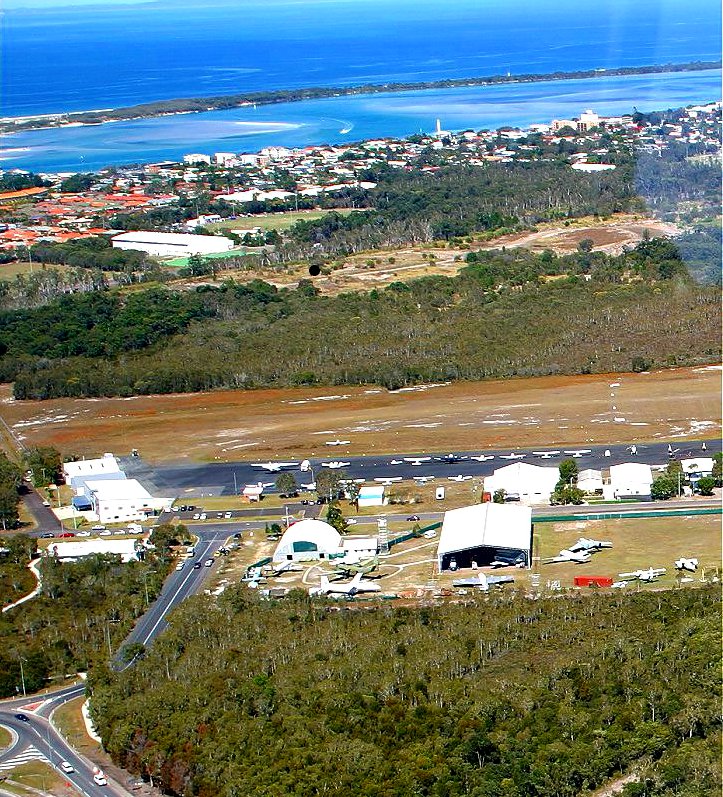



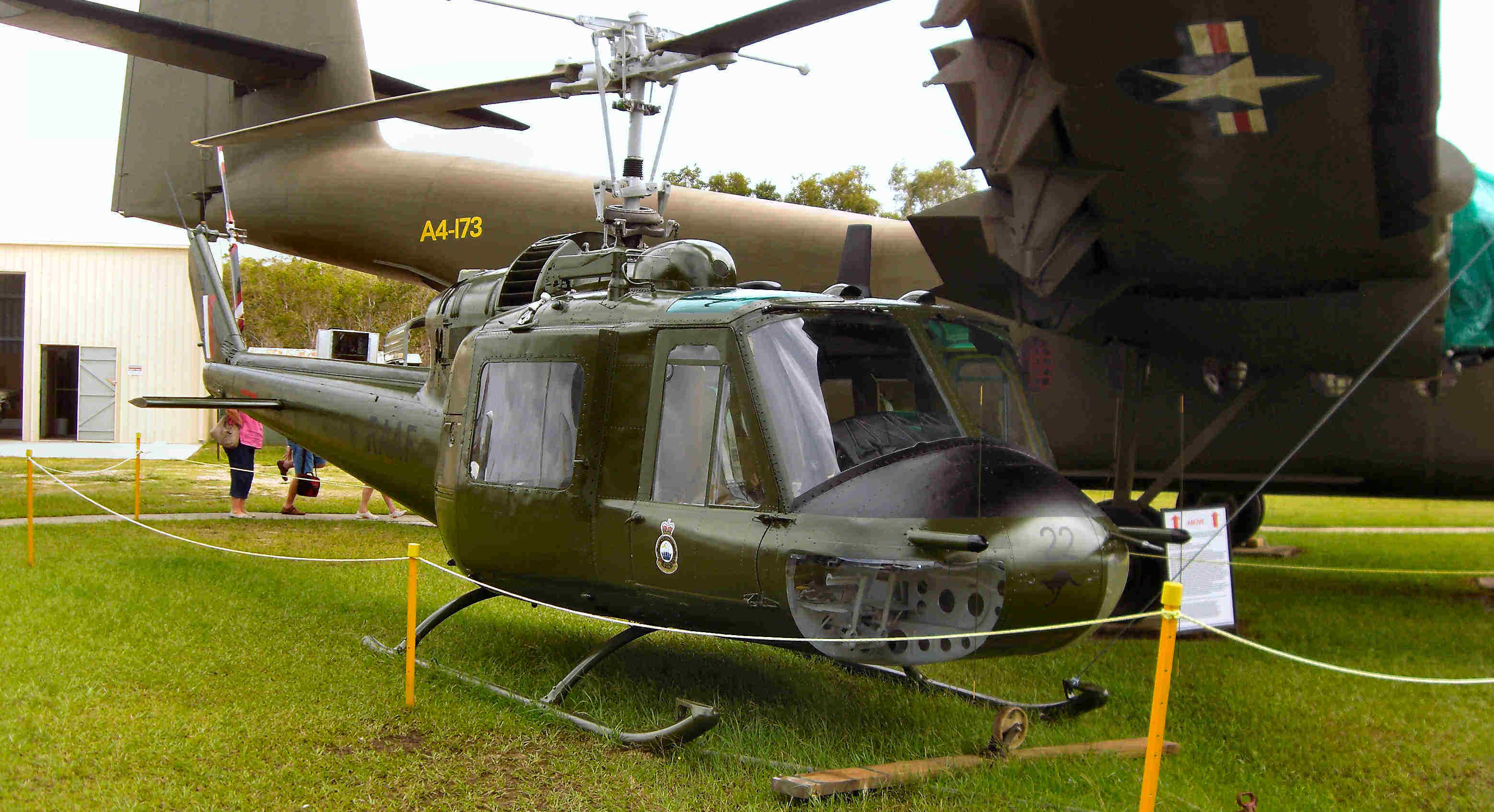
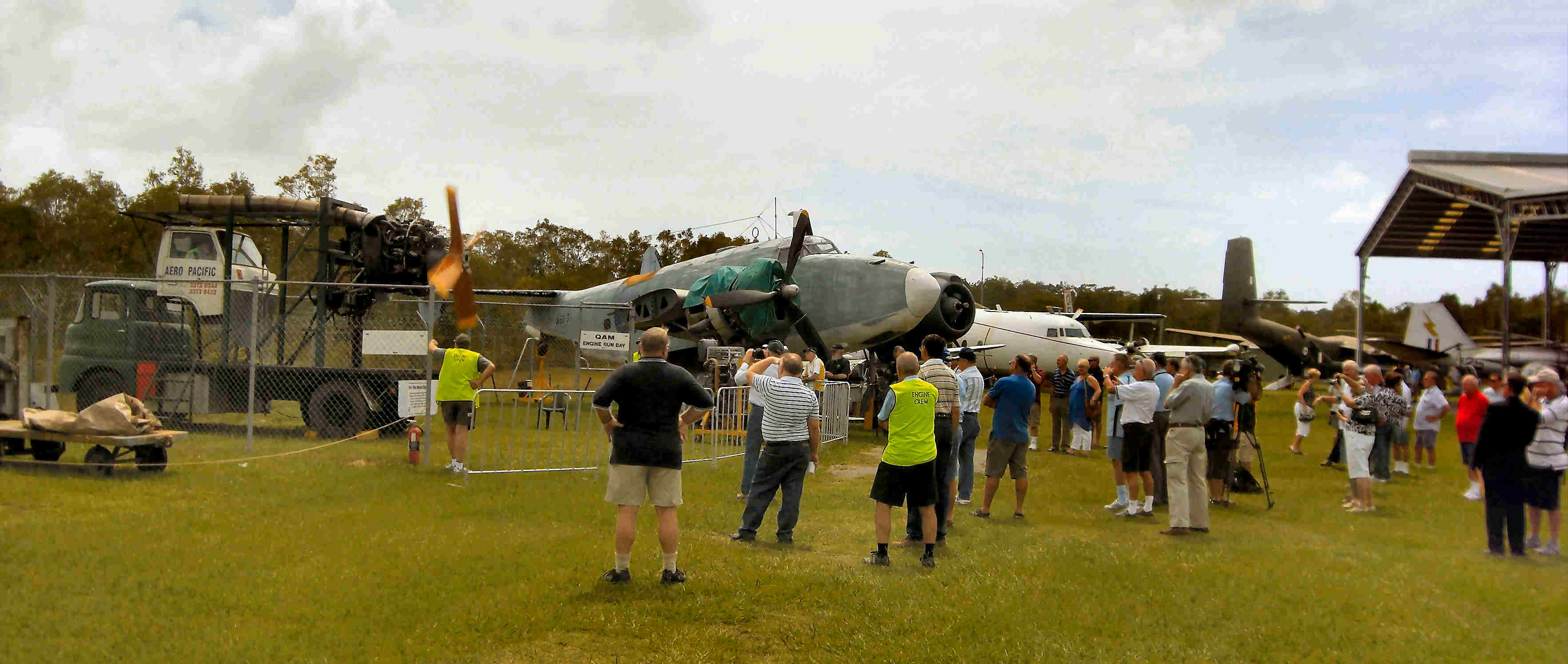
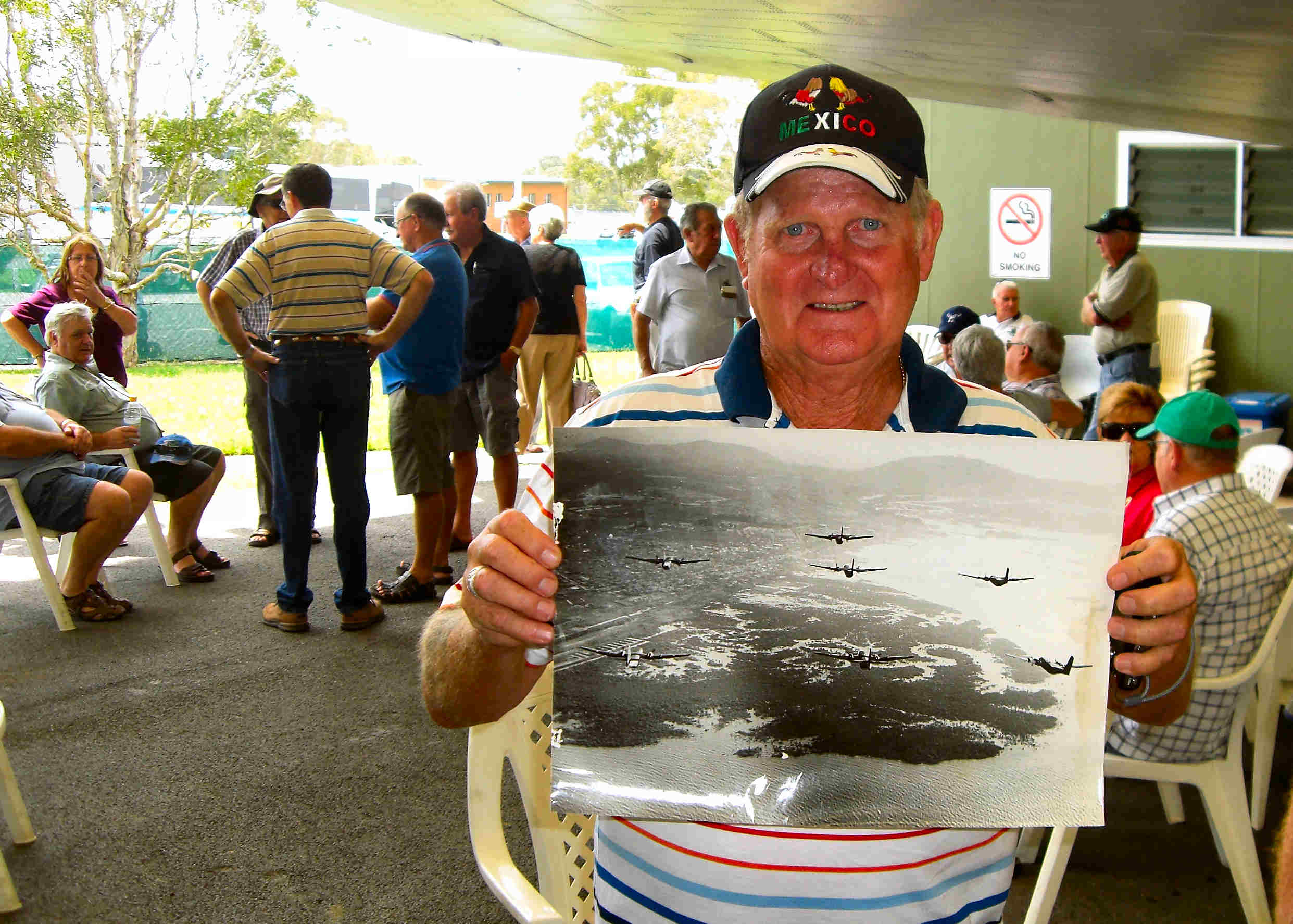
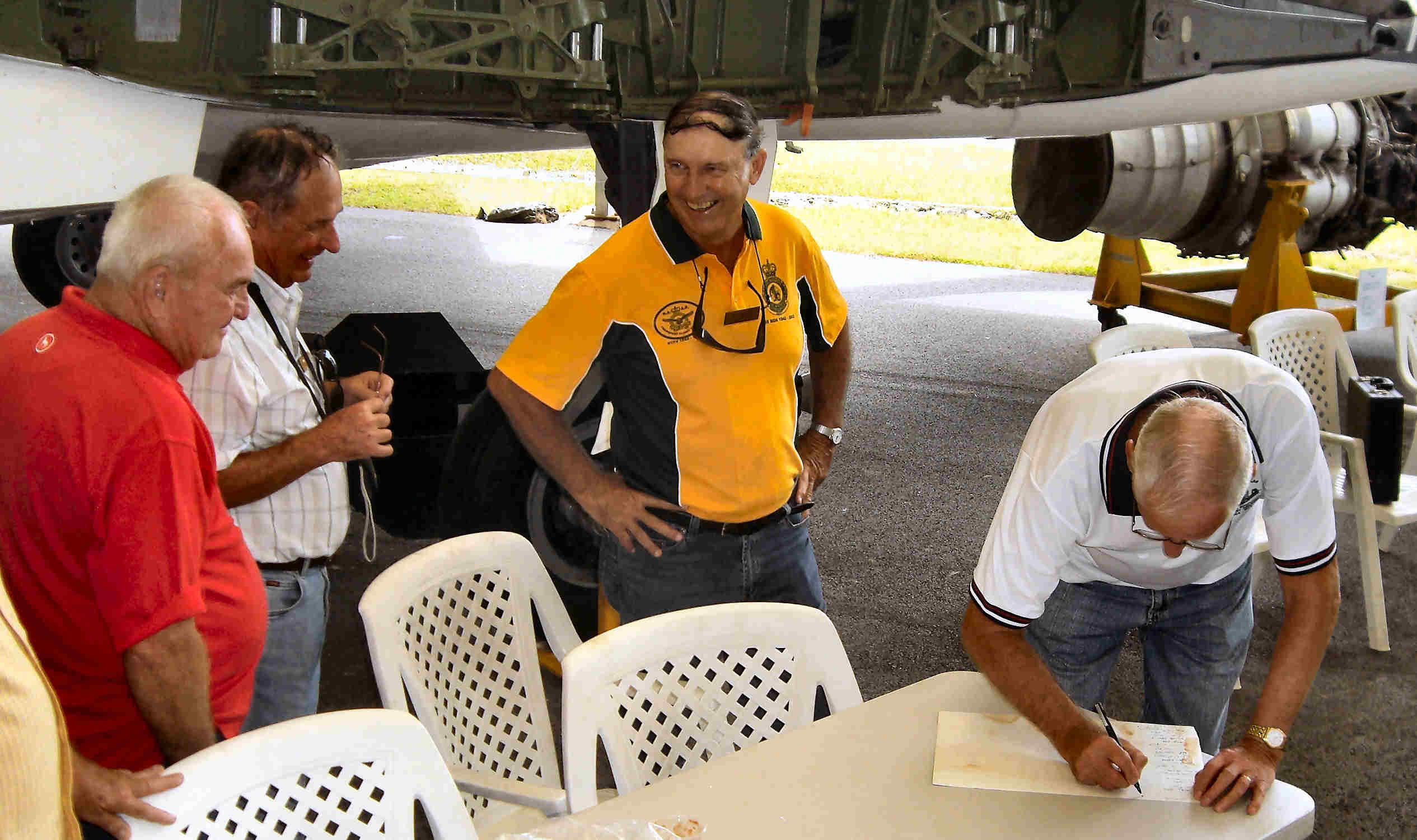
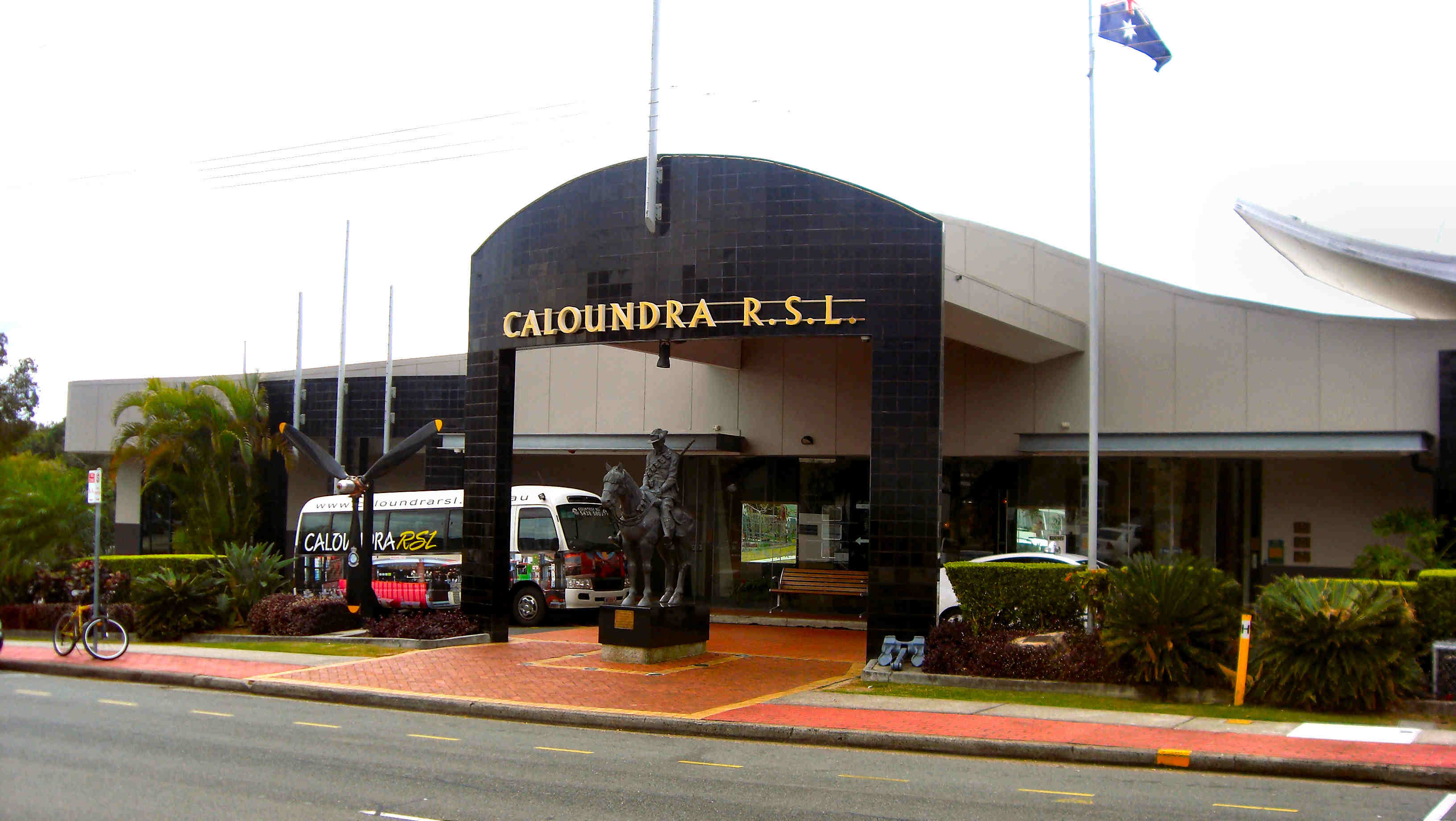

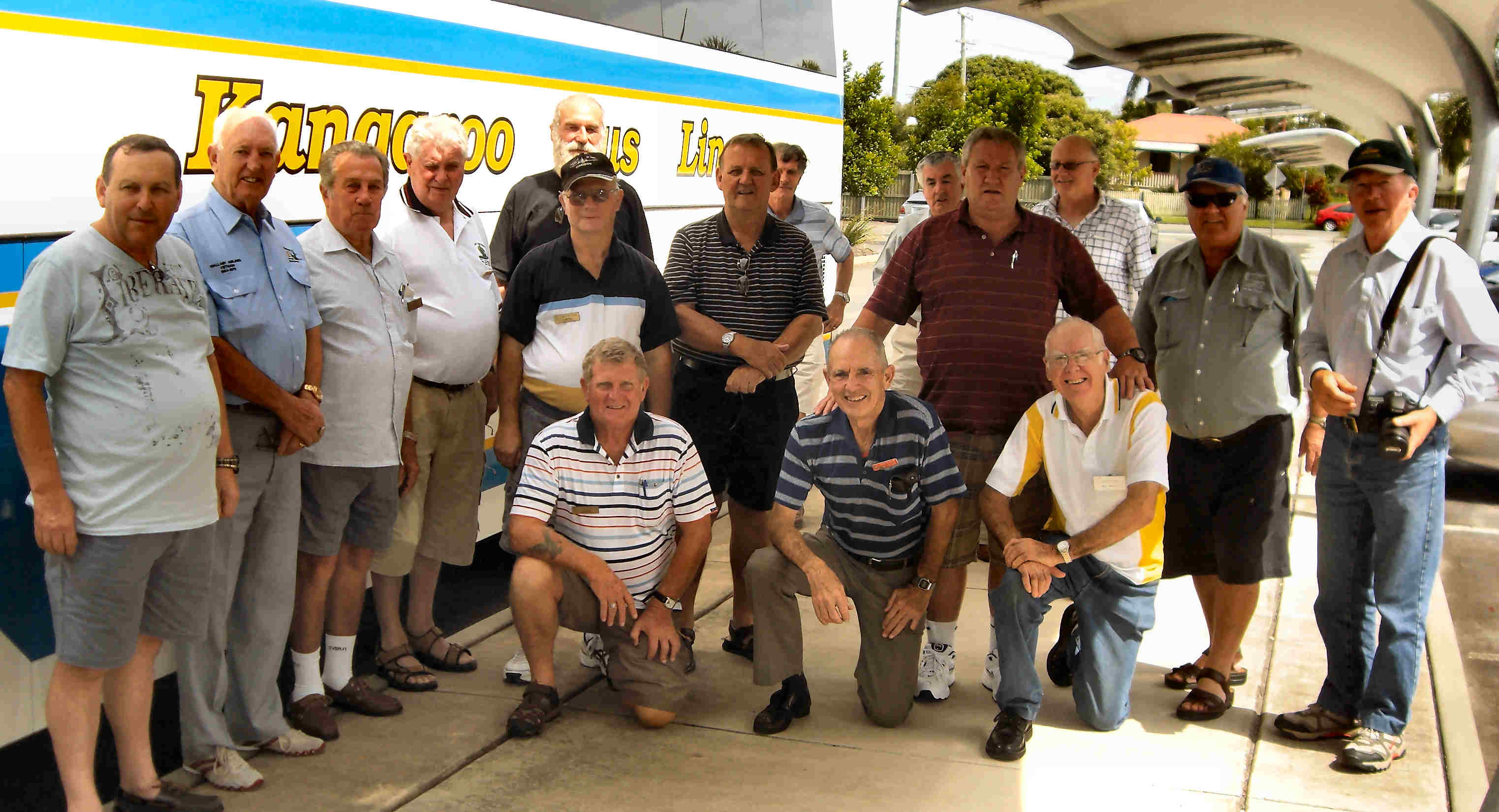
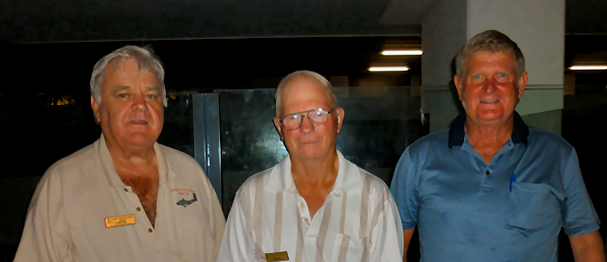

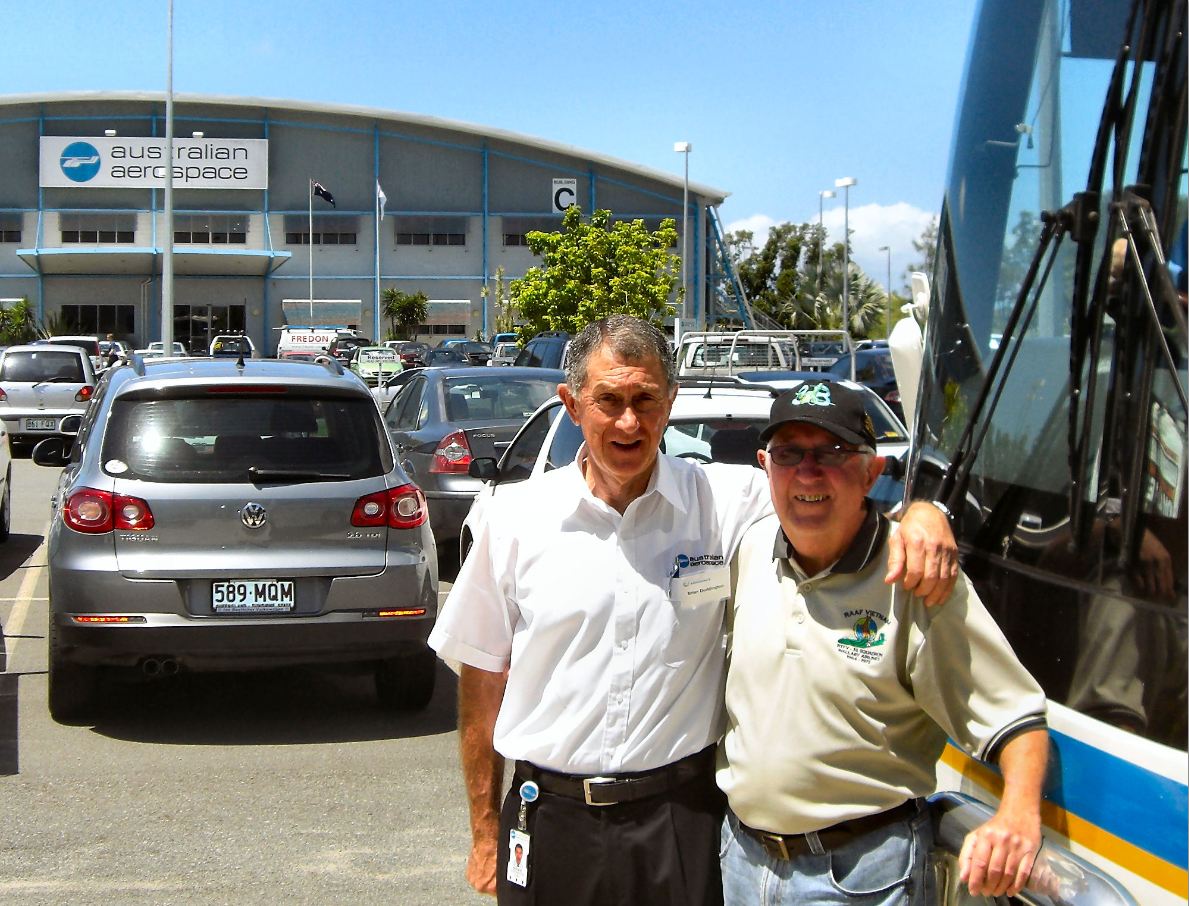
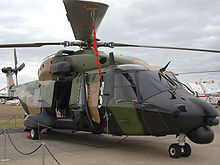 maintenance
of the Army and Navy's NH90 utility helicopter (left) and the Army's
European Tiger combat helicopter.
maintenance
of the Army and Navy's NH90 utility helicopter (left) and the Army's
European Tiger combat helicopter.
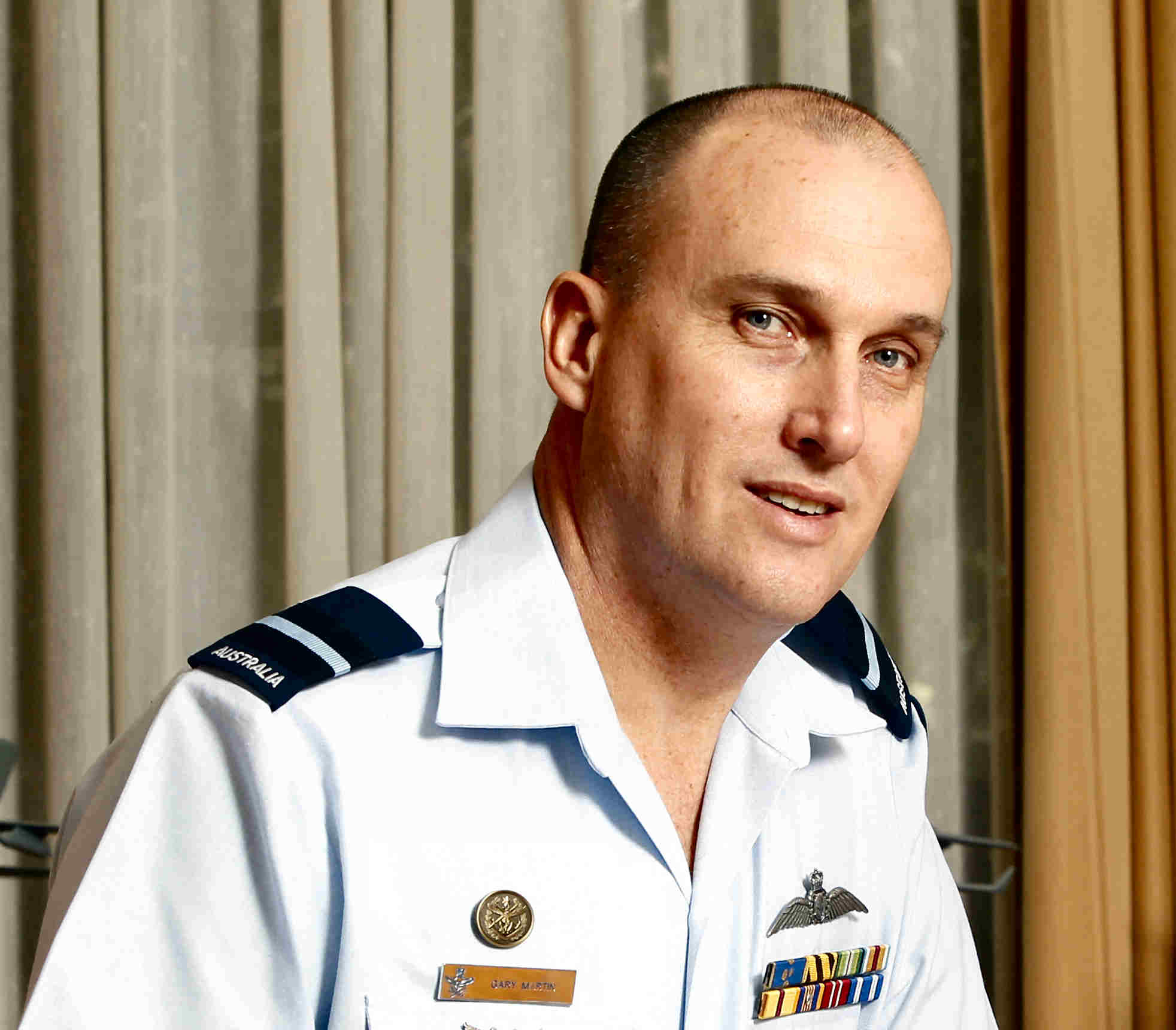 the 15th December 2011. Prior to that, he was the CO of 37 Squadron and
OC of 86 Wing. He also headed up the C-17 Transition Team. He was born
in Zimbabwe and joined the Zimbabwe Air Force where he qualified as a
Flight Instructor. He says, “A job opportunity in Australia became
available in 1989 so I joined the RAAF in June 1990” and started his
RAAF career as a QFI at Point Cook. The Zimbabwe
lifestyle and standards of education and health were not as good as they
could be so leaving and coming to Australia with his family was really a
‘no brainer’ for him.
the 15th December 2011. Prior to that, he was the CO of 37 Squadron and
OC of 86 Wing. He also headed up the C-17 Transition Team. He was born
in Zimbabwe and joined the Zimbabwe Air Force where he qualified as a
Flight Instructor. He says, “A job opportunity in Australia became
available in 1989 so I joined the RAAF in June 1990” and started his
RAAF career as a QFI at Point Cook. The Zimbabwe
lifestyle and standards of education and health were not as good as they
could be so leaving and coming to Australia with his family was really a
‘no brainer’ for him.